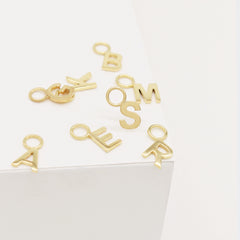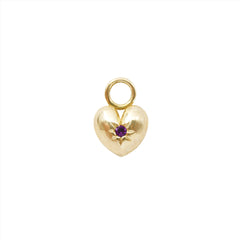EMERALDS
All gemstones are categorised into mineral species based on their chemical composition. Emeralds are part of the Beryl group, with a hardness of 7.5 - 8 on the Mohs Scale of hardness. (For reference, diamonds measure at 10 on the Mohs scale, so Emeralds are much softer and more brittle.) Emerald crystals are found in nature surrounded by black shale, with veins of pegmatite and schist rocks.
These crystals are usually included (this means they have tiny visible internal lines and cracks) and have fractures that gem experts call 'fissures' giving them loads of natural character! Therefore, completely clear Emeralds are really rare!
These crystals are usually included (this means they have tiny visible internal lines and cracks) and have fractures that gem experts call 'fissures' giving them loads of natural character! Therefore, completely clear Emeralds are really rare!
The quality of an emerald is based on the 4 C's, Cut, Colour, Clarity, and Carat weight, similar to diamonds, but with different requirements.
We have put together this sheet to help explain everything you need to consider when purchasing an Emerald.
All gemstones are graded using the combination of these characteristics to assess their quality and value. They are priced at the US dollar rate of the day. This means that our quotations are time-sensitive and subject to change.
Fun Facts: I. Emeralds are the birthstone for the month of May and mark the gift for the 20th and 30th wedding anniversaries.
2. Emeralds are known to be pleochroic, which means that they show different colors when observed at different angles.
Cut
This category refers firstly to the shape of the emerald i.e. Round, Oval, Pear, Princess, Emerald, Trilliant, etc.
This is purely dependent on personal preference and design aesthetic! The most common cuts for Emeralds are a cushion cut and an emerald cut.

Secondly, the cut grade of an emerald refers to how well it has been cut and depends on things like symmetry and proportions, as well as the quality of faceting and polish.
For us, this is perhaps the most important thing to consider when looking at gemstones to buy, as you want one that delivers a maximum return of colour & light.
Here, we also look at how the cut enhances the emerald's hue, tone, and saturation, as well as whether there is a comparatively safe place for claws to secure the stone with, protecting it against damage due to its brittle nature. Emeralds with lower-quality cut grades may be large or have nice colour but will appear dull.
We only consider emeralds with Very Good and Good Cut Grade for our clients, to ensure you are getting the best quality.
Clarity
Gemstones are formed far beneath the earth's surface and when exposed to tremendous pressure and heat, a variety of internal characteristics called "inclusions" and external characteristics occur.
Inclusions can consist of tiny crystals that are trapped while the stone is formed or irregularities in the atomic structure. They are a common occurrence in emeralds and as a result, their clarity is graded more leniently than other gemstones. Unlike diamonds, where a magnification loupe is used to grade its clarity, emeralds are graded under the naked eye. Often, inclusions in an emerald are called "Jardin", which is the French word for "the garden", because of their unique foliagelike appearance.
The clarity grading focuses on the presence of inclusions and how they affect transparency and appearance. Some inclusions do not compromise the durability or physical structure of the emerald in any way, but can still reduce its value. Emeralds that are eye-clean are very valuable because they are extremely rare.
It is important to note that inclusions need not be seen as a negative characteristic unless they affect the overall beauty of the stone.
Inclusions are what make your stone unique, and are also evidence of mineral formations from billions of years ago, proving that it is natural.
Inclusions are what make your stone unique, and are also evidence of mineral formations from billions of years ago, proving that it is natural.
Here is an overview of emerald clarity grading:

Colour
The colour grade of an emerald refers to the prescence of colour in the gemstone. Just like rubies, emeralds require trace amounts of colouring elements to give the gemstone its beautiful colour.
For Emeralds, these trace elements are specifically chromium, vanadium, and iron. In high-quality emeralds, the proportion of each element and the suitable physical environment for growth are required.
The variance of colour between different emeralds occurs due to differing amounts of trace elements, the environment in which the stones form, and the cut grade. Even the slightest difference in hue, colour, and saturation can have a huge impact on the price of an emerald. Darker, vivid greenish-blue emeralds are considered to be more valuable, so if an emerald is too dark or too light it becomes less costly.
The most vital aspect of choosing an emerald or any other coloured gem is choosing the shade of green that appeals to you the most, and depends largely on personal preference.
Here is an overview of emerald colour grading:

Carat
Carat weight refers to the size of an emerald. The value of an emerald increases with its carat weight, as it gets bigger (and heavier).
However, it is worth noting that a high-quality emerald with a lower carat weight can hold more value than a bigger emerald with a higher carat weight but lower quality due to factors like cut or colour.

Bonus 'C' - Character
The Four C's are the most traditional guide for determining a gemstone's quality. These measures will always hold value.
We believe in each emerald having an appeal that is not ncessarily included in the four C's, and this is why it is very important to view a few options before purchasing.
We are focused on finding the right emerald, for YOU.
Upcycling
We love working with family jewels and heirlooms. Creating new pieces containing old stones is our forte! We happily accept gemstones brought in by clients for their own pieces.
We will, however, always test the stones brought into our studio before accepting them, to determine whether they are genuine.
Caring for your Emeralds
Emeralds can crack or chip due to blunt force or a hard blow (especially heavily included emeralds). Therefore, we always recommend that you take extra special care of your emerald jewellery to ensure its signature sparkle.
These are our general care recommendations:
- Avoid exposure to any harsh chemicals
- Avoid wearing your jewels while swimming, hiking, washing dishes, gymming, or any activities where they are at risk of being knocked or scratched.
- Always clean your pieces with warm soapy water and a soft toothbrush. For any specific cleaning measures, we will make recommendations or ask you to visit the studio.
- Store your pieces somewhere SECURE, in its box, apart from other jewels which may cut or scratch them.
Bring your piece to the studio once a year for us to give it a proper professional clean and inspect it for any traumas or weakness in the settings.
Below are some examples of Emerald pieces we have made in our studio:







